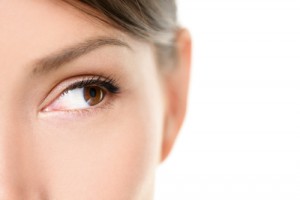Blepharoplasty (Eyelid Surgery)
 Blepharoplasty, or eyelid surgery, is one of the exceptional cosmetic facial procedures that can dramatically improve the appearance of the entire face. The procedure involves removing excess skin, muscle, and fat from the upper eyelids, the lower eyelids, or both for a younger, brighter, and more alert appearance. When determining whether one is a candidate for blepharoplasty, it is important to be aware that excess upper eyelid skin can be influenced by the position of the eyebrow. This is something that our skilled plastic surgeon—Richard Zeff, MD—will explain during consultation.
Blepharoplasty, or eyelid surgery, is one of the exceptional cosmetic facial procedures that can dramatically improve the appearance of the entire face. The procedure involves removing excess skin, muscle, and fat from the upper eyelids, the lower eyelids, or both for a younger, brighter, and more alert appearance. When determining whether one is a candidate for blepharoplasty, it is important to be aware that excess upper eyelid skin can be influenced by the position of the eyebrow. This is something that our skilled plastic surgeon—Richard Zeff, MD—will explain during consultation.
- What Is Eyelid Surgery (Blepharoplasty)?
- Eyelid Surgery Candidates
- Types of Eyelid Surgery
- Eyelid Surgery Procedure
- Eyelid Surgery Recovery
- Eyelid Surgery Scars
- Eyelid Surgery Results
- Eyelid Surgery Alternatives
- Eyelid Surgery Cost
- Additional Eyelid Surgery FAQs
What Is Eyelid Surgery (Blepharoplasty)?
Eyelid surgery, which is also called a blepharoplasty, is a facial plastic surgery procedure designed to rejuvenate and enhance the appearance of the upper and/or lower eyelids. Blepharoplasty can include the removal of excess skin and fat around the eyes, as well as the tightening of musculature, to correct droopy eyelids, puffiness, and under-eye bags. The goal of this procedure is to create smoother, more youthful-looking eyes that reflect a naturally refreshed and energized appearance. Dr. Zeff’s experience and skill performing eyelid surgery allow him to consistently create results that look balanced and not overly “done.”
Am I a Candidate for Eyelid Surgery?
The typical blepharoplasty candidate wants to achieve a more youthful facial aesthetic by reducing moderate to severe wrinkles, puffiness, and other signs of aging around the eyes. In addition to having these cosmetic goals, the ideal candidate will be in relatively good health and have realistic expectations for the outcome of the procedure. Dr. Zeff can determine whether blepharoplasty or another treatment is best for you during an initial consultation.
What Types of Eyelid Surgery Are Performed?
There are a few different types of eyelid surgery that are suitable for addressing a variety of cosmetic concerns caused by aging and/or genetics. Included below are explanations of each type of blepharoplasty Dr. Zeff performs:
Upper Eyelid Surgery
Upper blepharoplasty is generally indicated to address excess skin, puffiness, or heaviness in the upper eyelids. By removing extra skin and fat deposits from the upper eyelid area, Dr. Zeff can restore smooth, youthful definition to the eyelid crease, reduce the appearance of tired eyes, and reduce vision obstructions caused by drooping skin. Lax musculature can also be tightened to further support the eyelids. For some patients, brow and forehead laxity may contribute to drooping upper lids, indicating that a brow lift may provide additional rejuvenation in combination with upper blepharoplasty.
Lower Eyelid Surgery
Lower blepharoplasty is designed to correct the appearance of the under-eye area. Drooping lower eyelids, excess skin, puffy under-eye bags, and/or hollows can all be addressed with lower eyelid surgery techniques. During customized lower blepharoplasty, Dr. Zeff can remove excess drooping skin, remove unwanted fat volume, and lift lower lid positioning by tightening ligaments that support the lower eyelids. The goal of lower eyelid surgery is to lift, smooth, and rejuvenate the under-eye area for a more youthful and refreshed appearance. For patients with advanced aging in the under-eye and midface region, lower blepharoplasty may be combined with a mid-facelift, dermal fillers, and/or facial fat grafting techniques to enhance the quality of the final outcome.
During your consultation with Dr. Zeff, he will perform a full evaluation of your eyes and face to determine the best approach for rejuvenating your appearance and achieving the outcome you desire. For optimal results, each eyelid surgery procedure is highly customized to suit the unique needs and goals of each patient.
What Happens During the Eyelid Surgery Procedure?
Depending on the specific needs and goals of the patient, blepharoplasty can be performed on the upper or lower eyelids, or both. Upper eyelid surgery involves removing skin and fat from the upper eyelids. Incisions are made in the natural creases of the eyelids to hide the scarring. Lower eyelid surgery involves removal of excess fat, which often present as bags and dark circles beneath the eyes, exaggerating a tired appearance. Sometimes only fat needs to be removed, in which case no skin incisions are necessary. When excess skin needs to be removed, incisions are made just beneath the lash line and are closed with fine sutures to minimize scarring. For finer wrinkling without too much excess skin, laser resurfacing can sometimes be an alternative to incisions.
What Can I Expect During Eyelid Surgery Recovery?
Following eyelid surgery, temporary swelling, bruising, and soreness should be expected. Typically, these effects take a few days to a week to fade, depending on the details of your procedure and your unique rate of healing. The majority of patients opt to take about a week off from work to relax and recover. Dr. Zeff recommends taking it easy and abstaining from exercise for at least three weeks after surgery. To promote optimal healing, patients should closely adhere to all post-operative care instructions and attend all scheduled follow-up appointments with Dr. Zeff.
Will Eyelid Surgery Leave Scars?
While scarring is possible in the case of any cosmetic surgery, Dr. Zeff considers it the obligation of a good plastic surgeon to make the impact of surgery as inconspicuous as possible. As such, he takes care to place blepharoplasty incisions in easily-hidden locations, such as within the eyelid crease or beneath the lash line, to reduce the opportunity for noticeable scars.
We advise you to adhere to your aftercare instructions and return to the office for follow-up visits as recommended by Dr. Zeff. This will allow us to monitor your healing and potentially reduce the appearance of scars. If you are interested, we also offer non-surgical skin rejuvenation procedures (such as laser skin resurfacing), to address scarring
What Do Eyelid Surgery Results Look Like?
We invite you to explore Dr. Zeff’s eyelid surgery gallery, featuring before-and-after photos of his patients. More photos can be made available for viewing during your consultation appointment.
“I love the way I look!!! I have gotten so many compliments! I honestly love the way I feel about my new look! Thank you.”
Nancy – Barrington, NH
Are There Alternatives to Eyelid Surgery?
Many patients wonder if there are non-surgical alternatives to an eyelid lift in order to avoid the need for surgery. For some, injectable fillers can be the ideal solution to enhance and revitalize the area around the eyelids while avoiding a surgical procedure. Another popular injectable is BOTOX® Cosmetic, which can produce significant anti-aging results by smoothing unwanted creases and wrinkles. Depending on the patient, these can sometimes be an effective alternative to eyelid lift surgery, but keep in mind there is no alternative that can produce the same level of results as surgery.
Please also note that, in many cases, Dr. Zeff can incorporate other surgeries into your treatment for a more comprehensive facial enhancement. For example, if your concerns are more particular to the forehead and brow region, you may be better suited for brow lift surgery. This procedure can be especially effective for those who want to combat sagging or lax skin in the upper third of the face.
How Much Does Eyelid Surgery Cost?
The cost of eyelid surgery depends on the number of factors and to get a more exact estimate for the cost of your eyelid surgery procedure, we recommend scheduling a consultation with Dr. Zeff. During this appointment, Dr. Zeff can develop a customized surgical plan and a cost quote can be calculated based on the details of the proposed procedure. If additional procedures or treatments are recommended, they can also be added into the estimate. After your appointment, our knowledgeable office team can answer any questions you may have about pricing, financing options, payment methods, and scheduling your procedure.
Additional Eyelid Surgery Frequently Asked Questions
Is eyelid surgery covered by insurance?
Insurance coverage applying to eyelid surgery will ultimately depend on the patient’s insurance policy. Most commonly, eyelid surgery is not covered by insurance because the surgery is considered a cosmetic or aesthetic procedure not a medical one. Occasionally, insurance coverage may apply when eyelid surgery is being utilized to correct eyelids that have begun to impair a patient’s vision due to sagging and loose skin.
Will eyelid surgery improve my vision?
Eyelid surgery is not inherently designed to improve the vision of patients. Instead, the surgical procedure is an ideal method to eliminate sagging or loose skin that has developed on the eyelids over time. Reducing excess skin from the eyelids is generally a cosmetic treatment, improving only the appearance of your eyes and not the overall vision. If the sagging skin is so severe that it is blocking patients’ line of sight, eyelid surgery can in fact improve your vision by removing the obstruction.
What’s the difference between blepharoplasty and ptosis repair?
As mentioned above, blepharoplasty or eyelid surgery is generally sought after as a cosmetic solution to sagging or drooping skin on the eyelid, whereas ptosis repair is designed to repair muscles within the skin. Blepharoplasty can eliminate or remove extra fat and skin while ptosis repair manipulates weak tissue and muscles beneath the skin in order to restore function. Oftentimes, both blepharoplasty and ptosis repair are combined and performed in the same procedure to enhance the overall results.
How can I reduce swelling after eyelid surgery?
Although a normal part of recovery, the swelling that patients may experience following eyelid surgery can be irritating, but there are methods to reduce your overall discomfort after your procedure. Many patients have found success by lightly applying a cold compress to the eyelids in the first 24 to 48 hours when swelling will be most severe. Other methods include keeping your head elevated to avoid any additional fluid collection in your eyelids as well as avoiding direct sunlight or wearing sunglasses.
When can I wear contacts again after eyelid surgery?
Patients should avoid using their contact lenses for some time following their eyelid surgery to reduce the risk of infection and any additional discomfort. The targeted areas within the eyelid will be sensitive following the procedure, and any additional contact such as inserting and removing contact lenses can cause more discomfort and lead to possible infection. Patients who receive eyelid surgery are generally instructed to wear glasses and refrain from using contact lenses for about two weeks following their procedure.
When can I wear eye makeup after blepharoplasty?
Similar to wearing contacts after eyelid surgery, patients should avoid using eye makeup immediately following their procedure as well. Applying eye makeup can cause serious irritation, discomfort, and potential pain as the area targeted for surgery may be extremely sensitive in the initial weeks of recovery. Patients who undergo blepharoplasty should wait about two to three weeks before returning to their regular makeup routine.
Contact Our Office
To learn whether you are an eyelid surgery candidate, contact our practice today to schedule a private blepharoplasty consultation.







